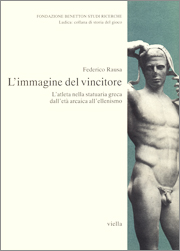
L’immagine del vincitore
L’atleta nella statuaria greca dall’età arcaica all’ellenismo
[The image of the victor. The athlete in Greek statuary from the Archaic period to Hellenism]
by Federico Rausa
Fondazione Benetton Studi Ricerche-Viella
Treviso-Rome 1994
304 pages
49 illustrations black and white
euros 25.82
ISBN 88-85669-31-X
(Ludica, 2)
From the end of the 6th century BC, Greek sculptors began to produce bronze statues of athletes dedicated to the winners of the sacred Pan-Hellenic games. These figures of ideal humanity were placed near the temples in the sanctuaries, especially those at Olympia and Delphi, and over the three and a half centuries the tradition lasted their creators included such supreme artists as Pythagorus, Myron and Lysippus.
This study uses written and figured sources to account for the origins and development of the statue of the athlete, including some aspects of the phenomenon in Roman times. The nucleus of the work earned the author a “Stefano Benetton” scholarship in 1987-1988 and the Foundation also provided help to ensure its completion and publication.
Contents
Introduzione, p. 7
Parte prima
1. L’immagine dell’atleta: significato e aspetti iconografici, p. 13: 1.1. La statua atletica come monumento onorario, p. 14; 1.2. Le statue atletiche dette “iconiche”, p. 19; 1.3. Caratteri dell’iconografia atletica nella scultura, p. 29
2. Athla e contesti topografici: statue greche nei centri della períodos e in altri siti, p. 39: 2.1. Olimpia, p. 39; 2.2. Delfi, p. 52; 2.3. Isthmia, p. 63; 2.4. Nemea, p. 65; 2.5. Località estranee alla períodos, p. 66
Parte seconda
1. Età arcaica, p. 77
2. Dal tardo arcaismo alla fine del V secolo, p. 85: 2.1. Athla e poesia d’encomio, p. 86; 2.2. Statue atletiche del tardo arcaismo, p. 93; 2.3. La statuaria atletica dell’età dello stile severo, p. 96; 2.4. Mirone, p. 101; 2.5. Policleto, p. 104
3. Il IV secolo, p. 111: 3.1. La produzione di statue atletiche fino alla metà del IV secolo, p. 118; 3.2. L’ideale atletico di Lisippo e la statuaria atletica della seconda metà del IV secolo, p. 127; 3.3. Sculture atletiche di stile lisippeo, p. 135; 3.4. Altri scultori di statue atletiche, p. 144
4. L’età ellenistica, p. 149: 4.1. L’eredità di Lisippo e gli ultimi esiti della statuaria atletica, p. 152; 4.2. Gruppi di lottatori, p. 158; 4.3. La statuaria atletica in età romana, p. 161
Conclusioni, p. 167
Catalogo, p. 169
Glossario dei termini tecnici che compaiono nel testo, p. 215; Sigle di riviste e periodici, p. 223; Abbreviazioni bibliografiche, p. 225; Indice dei passi citati, p. 235; Indice dei tipi statuari, p. 243; Indice dei musei e dei luoghi di conservazione, p. 245; Indice dei nomi e delle cose notevoli, p. 253; Elenco delle illustrazioni, p. 263; Tavole, p. 267
